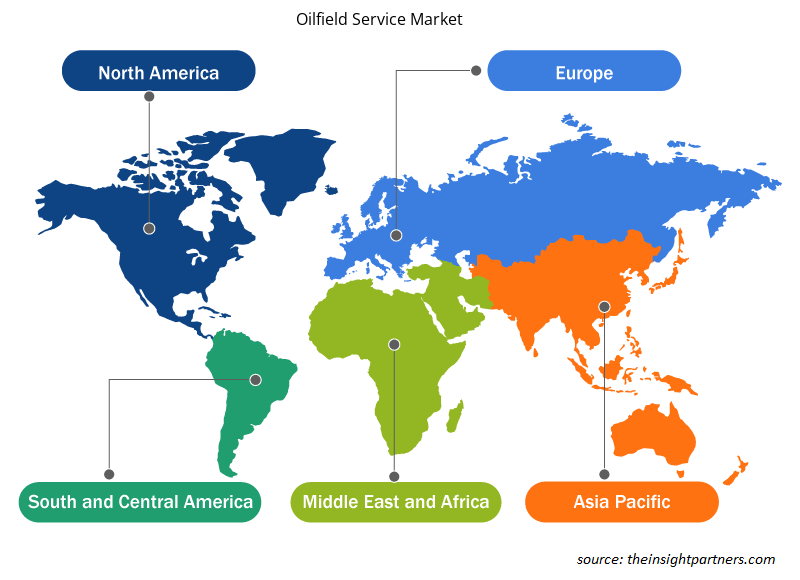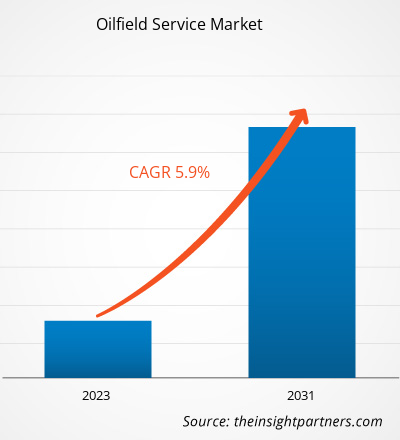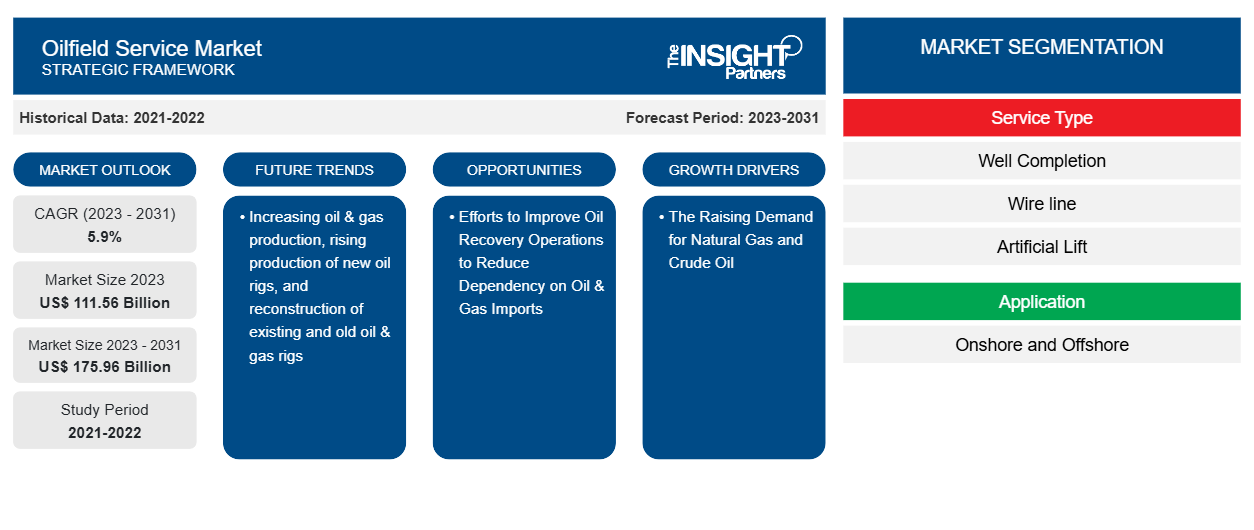Si prevede che la dimensione del mercato dei servizi per i giacimenti petroliferi raggiungerà i 175,96 miliardi di dollari entro il 2031, rispetto ai 111,56 miliardi di dollari del 2023. Si prevede che il mercato registrerà un CAGR del 5,9% nel periodo 2023-2031. L'aumento della produzione di petrolio e gas, la crescente produzione di nuove piattaforme petrolifere e la ricostruzione di piattaforme petrolifere e gas esistenti e vecchie rimarranno probabilmente tendenze chiave nel mercato.
Analisi del mercato dei servizi per i giacimenti petroliferi
Si prevede che il mercato dei servizi per i giacimenti petroliferi registrerà una crescita considerevole durante il periodo di tempo analizzato a causa del crescente numero di progetti di gas naturale e della scoperta di nuovi giacimenti petroliferi, in particolare in località remote. Inoltre, l'esaurimento delle riserve di petrolio e gas esistenti in vari paesi ha creato una domanda di oleodotti transfrontalieri per la fornitura di prodotti correlati a petrolio e gas, il che sta stimolando la crescita del mercato dei servizi per i giacimenti petroliferi. La crescente domanda di metodi di trasporto convenienti per petrolio e gas è uno dei principali fattori che si prevede stimolerà la domanda di servizi per i giacimenti petroliferi nel settore petrolifero e del gas estero in tutto il mondo.
Panoramica del mercato dei servizi per i giacimenti petroliferi
Con l'aumento della popolazione e dell'industrializzazione, anche la domanda di energia sta aumentando a livello globale. L'aumento del consumo di energia ha anche aumentato la necessità di petrolio e gas nelle economie in via di sviluppo e sviluppate. Ciò ha portato a un aumento della domanda di servizi per giacimenti petroliferi in tutto il mondo. Inoltre, la grande popolazione, l'elevato reddito pro capite e la rapida industrializzazione stanno guidando il mercato dei raccordi e delle flange per tubi petroliferi e del gas offshore nell'Asia Pacifica. La regione è il più grande consumatore di petrolio greggio e gas. Inoltre, i paesi altamente industrializzati nell'Asia Pacifica, tra cui Giappone, Cina, India e Corea del Sud, stanno segnalando un aumento del consumo energetico complessivo. Questi paesi stanno aumentando la loro attenzione nel potenziare la produzione nazionale di petrolio attraverso varie tecniche di recupero del petrolio migliorate, che stanno supportando la crescita del mercato nell'APAC per soddisfare la crescente domanda di petrolio.
Personalizza questo report in base alle tue esigenze
Riceverai la personalizzazione gratuita di qualsiasi report, comprese parti di questo report, o analisi a livello nazionale, pacchetto dati Excel, oltre a usufruire di grandi offerte e sconti per start-up e università
- Scopri le principali tendenze di mercato in questo rapporto.Questo campione GRATUITO includerà analisi di dati che spaziano dalle tendenze di mercato alle stime e alle previsioni.
Driver e opportunità del mercato dei servizi per i giacimenti petroliferi
La crescente domanda di gas naturale e petrolio greggio favorisce il mercato
La domanda di petrolio e gas naturale sta assistendo a un aumento costante in tutto il mondo. Gli Stati Uniti e la Cina hanno registrato la crescita più considerevole. Il robusto aumento della domanda petrolchimica negli Stati Uniti ha portato a un aumento dei consumi. L'impennata della produzione industriale, insieme all'elevata domanda di servizi di autotrasporto, sta aumentando la domanda di prodotti petrolchimici , alimentando così la crescita del mercato dei servizi per i giacimenti petroliferi. Inoltre, la crescita dei volumi di traffico aereo in tutto il mondo, in particolare nelle economie in via di sviluppo dell'Asia, è un altro fattore significativo che determina un aumento del consumo di petrolio.
Sforzi per migliorare le operazioni di recupero del petrolio per ridurre la dipendenza dalle importazioni di petrolio e gas
Il metodo di iniezione di vapore è stato sfruttato commercialmente negli ultimi decenni per migliorare il recupero dai giacimenti convenzionali di petrolio pesante nelle loro fasi successive di sviluppo. Il vapore iniettato aumenta la pressione complessiva di un giacimento petrolifero offshore, il che aiuta a migliorare il rapporto di mobilità del petrolio greggio e gli consente di fluire in modo efficiente. Di conseguenza, i metodi di recupero del petrolio migliorati aiutano a rivitalizzare i processi di estrazione nei pozzi petroliferi offshore esistenti. Vari paesi stanno investendo in sforzi per ringiovanire le loro risorse petrolifere esistenti per aumentare la produzione petrolifera nazionale e ridurre la loro dipendenza dalle importazioni di petrolio. Pertanto, si prevede che l'espansione prevista delle loro operazioni di petrolio e gas offrirà promettenti opportunità di crescita per gli operatori del mercato dei servizi per i giacimenti petroliferi nei prossimi anni.
Analisi della segmentazione del rapporto di mercato sui servizi per i giacimenti petroliferi
I segmenti chiave che hanno contribuito alla derivazione dell'analisi del mercato dei servizi per i giacimenti petroliferi sono il tipo di servizio e l'applicazione.
- In base al tipo di servizio, il mercato dei servizi per i giacimenti petroliferi è suddiviso in completamento pozzi, wireline, sollevamento artificiale, perforazione, fluidi di perforazione e completamento e altri. Il segmento degli altri ha detenuto la quota di mercato dei servizi per i giacimenti petroliferi più grande nel 2023.
- In base al tipo di materiale, il mercato è segmentato in onshore e offshore. Il segmento onshore ha detenuto la quota maggiore nel mercato dei servizi per i giacimenti petroliferi nel 2023.
Analisi della quota di mercato dei servizi per i giacimenti petroliferi per area geografica
L'ambito geografico del rapporto sul mercato dei servizi per i giacimenti petroliferi è suddiviso principalmente in cinque regioni: Nord America, Asia Pacifico, Europa, Medio Oriente e Africa, Sud e Centro America.
Il mercato dei servizi per i giacimenti petroliferi in Nord America è suddiviso in sottosegmenti negli Stati Uniti, in Canada e in Messico. La regione domina il mercato globale dei servizi per i giacimenti petroliferi grazie a vasti progetti di esplorazione e produzione di petrolio e gas e a un'ondata di nuove attività negli Stati Uniti, nel Golfo del Messico e in Canada. In quell'anno negli Stati Uniti c'erano 912.962 pozzi di petrolio e gas. Un aumento del numero di pozzi orizzontali negli Stati Uniti e un aumento della produzione di petrolio e gas di scisto per piattaforma contribuiscono alla crescita del mercato dei servizi per i giacimenti petroliferi nel paese. L'emergere di sistemi avanzati di servizi intelligenti per i giacimenti petroliferi, come i sistemi di completamento del controllo dell'afflusso autoadattativi di fascia alta, spingerebbe la crescita del mercato in Nord America negli anni a venire. L'elevata domanda di attrezzature onshore dovuta a prospettive significative nel bacino del Permiano e nel Dakota del Nord, specialmente in un numero sempre maggiore di progetti non convenzionali, farebbe prosperare la crescita del mercato dei servizi per i giacimenti petroliferi per il segmento onshore.
Approfondimenti regionali sul mercato dei servizi per i giacimenti petroliferi
Le tendenze regionali e i fattori che influenzano il mercato dei servizi per i giacimenti petroliferi durante il periodo di previsione sono stati ampiamente spiegati dagli analisti di Insight Partners. Questa sezione discute anche i segmenti e la geografia del mercato dei servizi per i giacimenti petroliferi in Nord America, Europa, Asia Pacifico, Medio Oriente e Africa, e America centrale e meridionale.

- Ottieni i dati specifici regionali per il mercato dei servizi per i giacimenti petroliferi
Ambito del rapporto sul mercato dei servizi per i giacimenti petroliferi
| Attributo del report | Dettagli |
|---|---|
| Dimensioni del mercato nel 2023 | 111,56 miliardi di dollari USA |
| Dimensioni del mercato entro il 2031 | 175,96 miliardi di dollari USA |
| CAGR globale (2023-2031) | 5,9% |
| Dati storici | 2021-2022 |
| Periodo di previsione | 2023-2031 |
| Segmenti coperti | Per tipo di servizio
|
| Regioni e Paesi coperti | America del Nord
|
| Leader di mercato e profili aziendali chiave |
|
Densità degli attori del mercato: comprendere il suo impatto sulle dinamiche aziendali
Il mercato Oilfield Service Market sta crescendo rapidamente, spinto dalla crescente domanda degli utenti finali dovuta a fattori quali l'evoluzione delle preferenze dei consumatori, i progressi tecnologici e una maggiore consapevolezza dei vantaggi del prodotto. Con l'aumento della domanda, le aziende stanno ampliando le loro offerte, innovando per soddisfare le esigenze dei consumatori e capitalizzando sulle tendenze emergenti, il che alimenta ulteriormente la crescita del mercato.
La densità degli operatori di mercato si riferisce alla distribuzione di aziende o società che operano in un particolare mercato o settore. Indica quanti concorrenti (operatori di mercato) sono presenti in un dato spazio di mercato in relazione alle sue dimensioni o al valore di mercato totale.
Le principali aziende che operano nel mercato dei servizi per i giacimenti petroliferi sono:
- Schlumberger Limited
- Società per azioni Weatherford International
- Azienda Baker Hughes
- Società Halliburton
- National Oilwell Varco, Inc.
- TecnologiaFMC
Disclaimer : le aziende elencate sopra non sono classificate secondo un ordine particolare.

- Ottieni una panoramica dei principali attori del mercato dei servizi per i giacimenti petroliferi
Notizie e sviluppi recenti sul mercato dei servizi per i giacimenti petroliferi
Il mercato dei servizi per i giacimenti petroliferi viene valutato raccogliendo dati qualitativi e quantitativi dopo la ricerca primaria e secondaria, che include importanti pubblicazioni aziendali, dati associativi e database. Di seguito sono elencati alcuni degli sviluppi nel mercato dei servizi per i giacimenti petroliferi:
- Baker Hughes ha annunciato l'espansione del business Oilfield services and equipment in Guyana. Baker Hughes è pronta a sviluppare una nuova struttura supercentre in Guyana per servizi e attrezzature per giacimenti petroliferi. (Fonte: Baker Hughes, comunicato stampa, febbraio 2022)
- Schlumberger Limited ha annunciato il lancio del servizio di mappatura multistrato durante la perforazione Periscope Edge. Il servizio fornisce nuove misurazioni e un processo di inversione leader del settore, combinato con soluzioni cloud, per fornire un geo steering accurato nei bacini durante la perforazione. (Fonte: Schlumberger Limited, comunicato stampa, agosto 2021)
Copertura e risultati del rapporto sul mercato dei servizi per i giacimenti petroliferi
Il rapporto “Dimensioni e previsioni del mercato dei servizi per i giacimenti petroliferi (2021-2031)” fornisce un’analisi dettagliata del mercato che copre le seguenti aree:
- Dimensioni e previsioni del mercato dei servizi per i giacimenti petroliferi a livello globale, regionale e nazionale per tutti i segmenti di mercato chiave coperti dall'ambito
- Tendenze del mercato dei servizi per i giacimenti petroliferi e dinamiche di mercato come fattori trainanti, vincoli e opportunità chiave
- Analisi PEST e SWOT dettagliate
- Analisi del mercato dei servizi per i giacimenti petroliferi che copre le principali tendenze del mercato, il quadro globale e regionale, i principali attori, le normative e i recenti sviluppi del mercato
- Analisi del panorama industriale e della concorrenza che copre la concentrazione del mercato, l'analisi della mappa di calore, i principali attori e gli sviluppi recenti per il mercato dei servizi per i giacimenti petroliferi
- Profili aziendali dettagliati
- Analisi storica (2 anni), anno base, previsione (7 anni) con CAGR
- Analisi PEST e SWOT
- Valore/volume delle dimensioni del mercato - Globale, Regionale, Nazionale
- Industria e panorama competitivo
- Set di dati Excel
Report recenti
Testimonianze
Motivo dell'acquisto
- Processo decisionale informato
- Comprensione delle dinamiche di mercato
- Analisi competitiva
- Analisi dei clienti
- Previsioni di mercato
- Mitigazione del rischio
- Pianificazione strategica
- Giustificazione degli investimenti
- Identificazione dei mercati emergenti
- Miglioramento delle strategie di marketing
- Aumento dell'efficienza operativa
- Allineamento alle tendenze normative





















 Ottieni un campione gratuito per - Mercato dei servizi per i giacimenti petroliferi
Ottieni un campione gratuito per - Mercato dei servizi per i giacimenti petroliferi